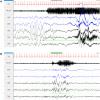Exclusion of EEG-based arousals in wake epochs of polysomnography leads to underestimation of the arousal index
- PMID: 35022129
- PMCID: PMC9059578
- DOI: 10.5664/jcsm.9878
Exclusion of EEG-based arousals in wake epochs of polysomnography leads to underestimation of the arousal index
Abstract
Study objectives: There is an internal contradiction in current American Academy of Sleep Medicine standards for arousal index (AI) calculation in polysomnography: Arousals in sleep and wake epochs are counted, but only sleep time is used in the denominator. This study aimed to investigate the impact of including arousals scored in wake epochs on the AI.
Methods: We compared AIs including (AIinc) vs excluding (AIexc) awake-epoch arousals from 100 consecutive polysomnograms conducted for investigation of possible obstructive sleep apnea. To determine the AI that most closely approximated "truth," AIinc and AIexc were compared to an AI calculated from continuous sleep analysis (AIcont) in a 20-polysomnogram subgroup of patients.
Results: The median (interquartile range) increase in AIinc was 5.2 events/h (3.5-8.1) vs AIexc (AIinc = 28.0 events/h [18.4-38.9] vs AIexc = 22.9 events/ h [13.1-31.3]), equating to an increase of 25.3% (15.6-40.8). As the AI increased, the difference increased (P < .001), with decreasing sleep efficiency and an increasing apnea-hypopnea index as the strongest predictors of the difference between AIexc and AIinc. The absolute AIexc-AIcont difference (7.7 events/h [5.1-13.6]) was significantly greater than the AIinc-AIcont difference (1.2 events/h [0.6-5.7]; z = -3.099; P = .002).
Conclusions: There was a notable increase in AI when we included wake-epoch arousals, particularly in patients with more severe obstructive sleep apnea or reduced sleep efficiency. However, the AI including wake-epoch arousals best matched the "true" continuous sleep-scoring AI. Our study informs clinical and research practice, highlights epoch scoring pitfalls, and supports the current American Academy of Sleep Medicine standard arousal reporting approach for future standards.
Citation: Wilson DL, Tolson J, Churchward TJ, Melehan K, O'Donoghue FJ, Ruehland WR. Exclusion of EEG-based arousals in wake epochs of polysomnography leads to underestimation of the arousal index. J Clin Sleep Med. 2022;18(5):1385-1393.
Keywords: analysis; arousal; continuous; epoch; polysomnography; wake.
© 2022 American Academy of Sleep Medicine.
Conflict of interest statement
All authors have seen and approved this manuscript. Work for this study was performed at the Sleep Laboratory within the Department of Respiratory and Sleep Medicine at Austin Health, Melbourne, and Royal Prince Alfred Hospital, Sydney. The authors report no conflicts of interest.
Figures



References
-
- Bonnet MH , Doghramji K , Roehrs T , et al. . The scoring of arousal in sleep: reliability, validity, and alternatives . J Clin Sleep Med. 2007. ; 3 ( 2 ): 133 – 145 . - PubMed
-
- American Academy of Sleep Medicine Task Force . Sleep-related breathing disorders in adults: recommendations for syndrome definition and measurement techniques in clinical research. The report of an American Academy of Sleep Medicine task force . Sleep. 1999. ; 22 ( 5 ): 667 – 689 . - PubMed
-
- Iber C , Ancoli-Israel S , Chesson AL Jr , Quan SF ; for the American Academy of Sleep Medicine . The AASM Manual for the Scoring of Sleep and Associated Events: Rules, Terminology and Technical Specifications. 1st ed . Westchester, IL: : American Academy of Sleep Medicine; ; 2007. .
-
- Berry RB , Quan SF , Abreu AR , et al. ; for the American Academy of Sleep Medicine . The AASM Manual for the Scoring of Sleep and Associated Events: Rules, Terminology and Technical Specifications. Version 2.6. Darien, IL: : American Academy of Sleep Medicine; ; 2020. .
-
- Bonnet MH , Carley D , Carskadon MA , et al. . EEG arousals: scoring rules and examples: a preliminary report from the Sleep Disorders Atlas Task Force of the American Sleep Disorders Association . Sleep. 1992. ; 15 ( 2 ): 173 – 184 . - PubMed
MeSH terms
LinkOut - more resources
Full Text Sources
Research Materials

